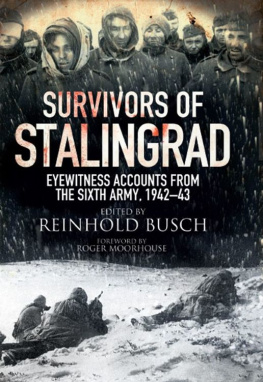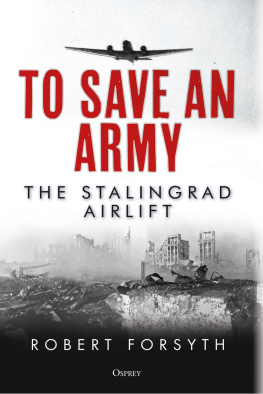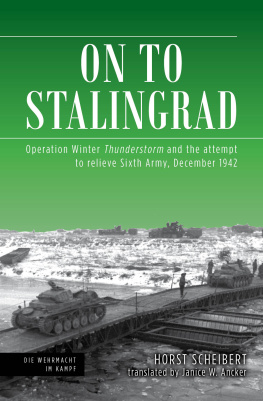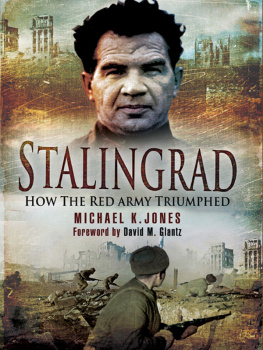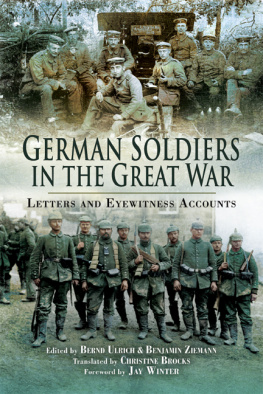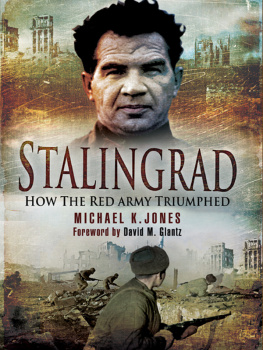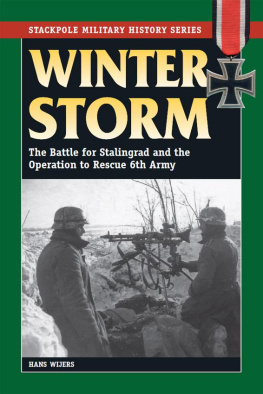SURVIVORS OF STALINGRAD
Eyewitness Accounts from the Sixth Army, 19421943
Edited by REINHOLD BUSCH
Translated by GEOFFREY BROOKS
Foreword by ROGER MOORHOUSE

Originally published in German in 2012 as Der Untergang der 6. Armee
This English edition first published in 2014 by Frontline Books

an imprint of Pen & Sword Books Ltd,
47 Church Street, Barnsley, S. Yorkshire, S70 2AS
www.pen-and-sword.co.uk
Copyright Ares Verlag, Graz 2012
Translation copyright Pen & Sword Books Ltd, 2014
Foreword copyright Pen & Sword Books Ltd, 2014
ISBN: 978-1-84832-766-5
All rights reserved. No part of this publication may be reproduced, stored in or introduced into a retrieval system, or transmitted, in any form, or by any means (electronic, mechanical, photocopying, recording or otherwise) without the prior written permission of the publisher. Any person who does any unauthorized act in relation to this publication may be liable to criminal prosecution and civil claims for damages.
CIP data records for this title are available from the British Library
For more information on our books, please visit
or write to us at the above address.
Printed and bound by CPI Group (UK) Ltd, Croydon, CR0 4YY
Typeset in Garamond by MATS Typesetting, Leigh-on-Sea, Essex
CONTENTS
Plate 1: Arthur Krger, Corporal, Danzig Infantry Regiment, one of the few survivors of Stalingrad; Self-portrait of Dr Kurt Reuber, painter of the famous Stalingrad Madonna; Gert Pfeiffer, Captain, 92nd Motorized Infantry Regiment, 60th Infantry Division; Captain Jochen Lser, winner of the Knights Cross for his involvement at Stalingrad on 26 January 1943.
Plate 2: Friedrich Randhagen, Workshop Company, 2nd Panzer Regiment, 16th Panzer Division; Stalingrad survivor Otto Schfer; Eyewitness to the fierce fighting at the Tractor Works, infantryman Helmut Walz; Infantryman Joachim Feuerich.
Plate 3: He 111 medium bombers; He 111 air-gunner and flight mechanic Michael Deiml; Knights Cross holder NCO Otto Gemnden.
Plate 4: A horse-drawn convoy advances across the steppe to the Volga.
Plate 5: Summer 1942: 305th Infantry Division on the road to Stalingrad; 100th Artillery Abteilung advancing across the steppe.
Plate 6: View from a trench looking towards the remains of an apartment block, Stalingrad.
Plate 7: Surviving chimney-stacks amongst the ruins of Stalingrad; German artillery firing on Stalingrad.
Plate 8: Panoramic view of the damage to Stalingrad; Russian refugees on the Stalingrad Rollbahn, September 1942.
Plate 9: Inside Fortress Stalingrad: Dr Kurt Reuber; Dr Kurt Reubers Stalingrad Madonna photographed in its position in front of the bunker.
Plate 10: Building bunkers in Fortress Stalingrad with local helpers; Christmas 1942: the slaughter of the last horse.
Plate 11: Infantrymen at the bitterly-contested Tractor Works; Sign post warning against entering the city of Stalingrad.
Plate 12: Ju 52 aircraft on the Tazinskaya airfield; A Ju 52 at Stalingrad.
Plate 13: The Univermag department store in the south of Stalingrad under fire; General Alexander von Hartmann (left) receiving the Knights Cross from Field-Marshal Paulus; Paulus leaving the Soviet car in which he was driven into captivity.
Plate 14: Three German soldiers on the brink of life and death; The appalling end of Sixth Army: piles of dead German soldiers at the end of the battle; Hermann Gring, Commander-in-Chief of the Luftwaffe.
Plate 15: An endless column of German prisoners of war march towards a Soviet death camp; Cameo of Sixth Army prisoners of war.
Plate 16: Soviet Katyusha rocket launchers known by the German side as Stalin Organs; General Hans-Valentin Hube.
by Roger Moorhouse
The battle for Stalingrad still carries enormous resonance. Like Kursk or Anzio, the name alone conveys its meaning. One of the bloodiest battles in history, consuming over a million lives at a conservative estimate, it was also one of the most important, signalling a genuine watershed in the conflict: what Churchill called a climacteric.
Unusually, Stalingrads significance was clearly evident even at the time. For the Soviets its defence was as much symbolic as strategic. As well as controlling the approaches to the oil-rich Caucasus and sitting on the western bank of the mighty Volga river, one of Russias most formidable natural obstacles, it was the city that bore Stalins name. For propaganda reasons alone, therefore, its surrender was unthinkable.
Militarily, too, the battle for Stalingrad was profoundly significant. Where the Red Army had struggled to come to terms with the German doctrine of Blitzkrieg over the previous two summers, at Stalingrad it launched an audacious Blitzkrieg of its own, sending armoured columns deep into the Axis rear, hitting at the more lightly defended flanks of the salient where the Italians, Hungarians and Romanians held the line and cutting off the German Sixth Army in a shrinking pocket to the west of the city, effectively besieging the besiegers. It was an astonishing reversal, finally and conclusively demonstrating the truth of Stalins optimistic assertion from July 1941 that no army was invincible. After this success, the Wehrmachts spell was broken and the Red Armys generals hardly looked back. To paraphrase one of Churchills neatest aphorisms: before Stalingrad the Red Army scarcely had a victory, after Stalingrad it scarcely had a defeat.
The Germans, too, were well aware of Stalingrads importance. The city lay on the high-water mark of Axis expansion and its loss heralded an ebb-tide that would sweep Soviet forces, with few interruptions, all the way to Berlin. The associated loss of the Caucasus was also a grievous blow, denying Hitler access to the vital Soviet oil-fields of Baku, Maikop and Grozny, without Stalingrad, therefore, was highly significant both as a strategic and a military turning point in the wider history of the Second World War.
Far from being concealed from the German people, as is so often assumed, or wished away with a propagandists flourish, the defeat at Stalingrad was acknowledged for the catastrophe to Hitlers ambitions that it was. The news was announced on German radio to the accompaniment of the sombre adagio to Bruckners Seventh Symphony, and three days of official mourning followed. Two weeks later, Propaganda Minister Joseph Goebbels would give his response to the crisis. In his famed Total War speech in Berlin, he cited the defeat at Stalingrad as a wake-up call to the German people; opening their eyes to the true nature of the war against the Bolsheviks, and to their historic duty to defend Western civilization. It was a duty whose importance would brook no half-measures, no compromises; instead, he declared, total war was the demand of the hour. In the aftermath, Nazi Germany would belatedly adopt a war economy, sacrificing most of the remaining civilian comforts for a strict prioritisation of the war effort. Too little, it would prove, too late.
Yet, aside from the propaganda and the posturing, Stalingrads profoundest consequences were human. The true death toll of the battle military and civilian, Soviet and German will never be known for sure; such was the slaughter that the proper retrieval, identification and burial of the dead was simply impossible. In total, it has been suggested that as many as two million people died in the battle. In addition, for the 90,000 or so Axis soldiers taken captive by the Soviets, their torments were not yet at an end. Condemned to punitive hard labour in the infamous camps of the Gulag, few would survive. Barely 6 per cent of them would ever see their homelands again.

